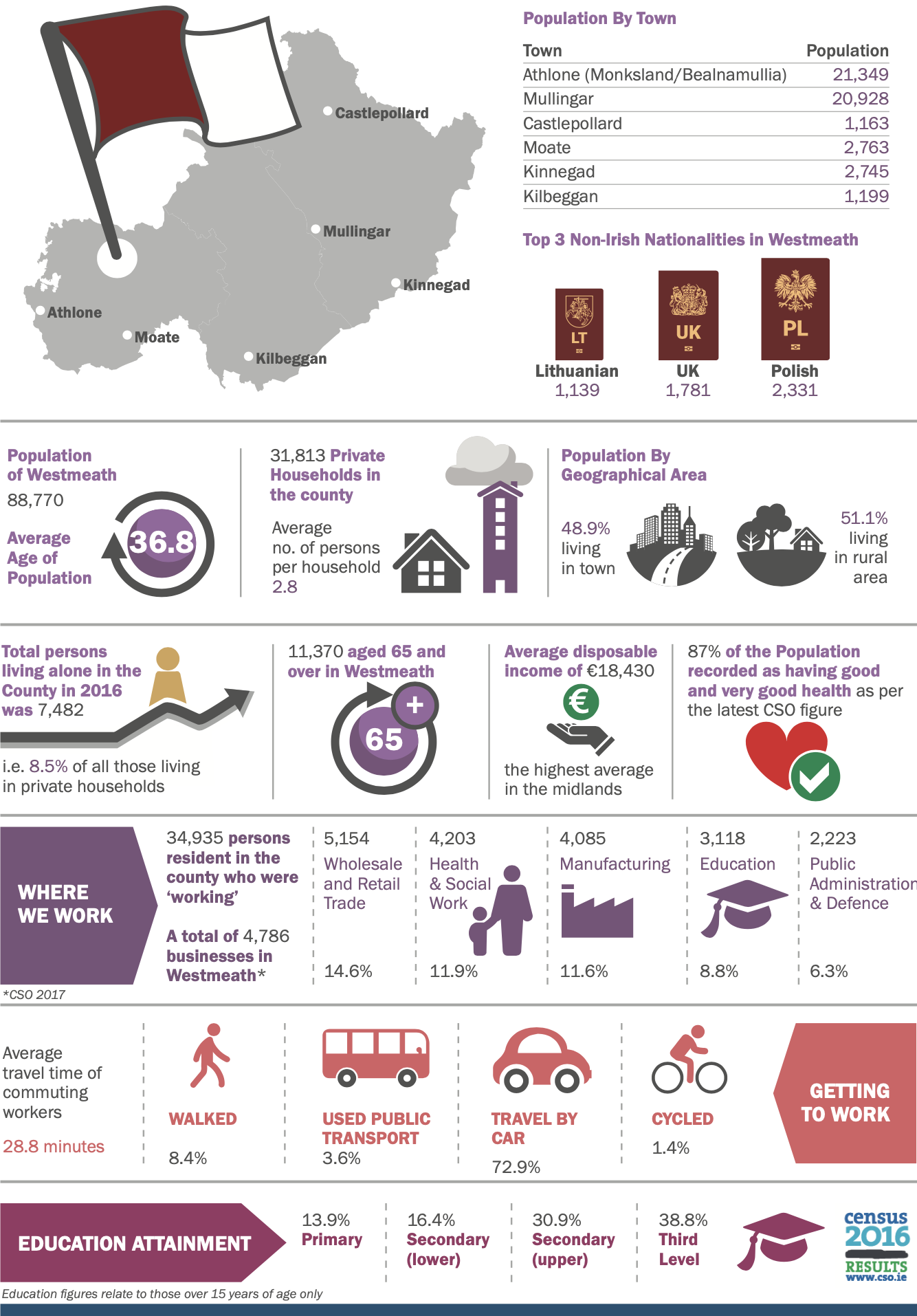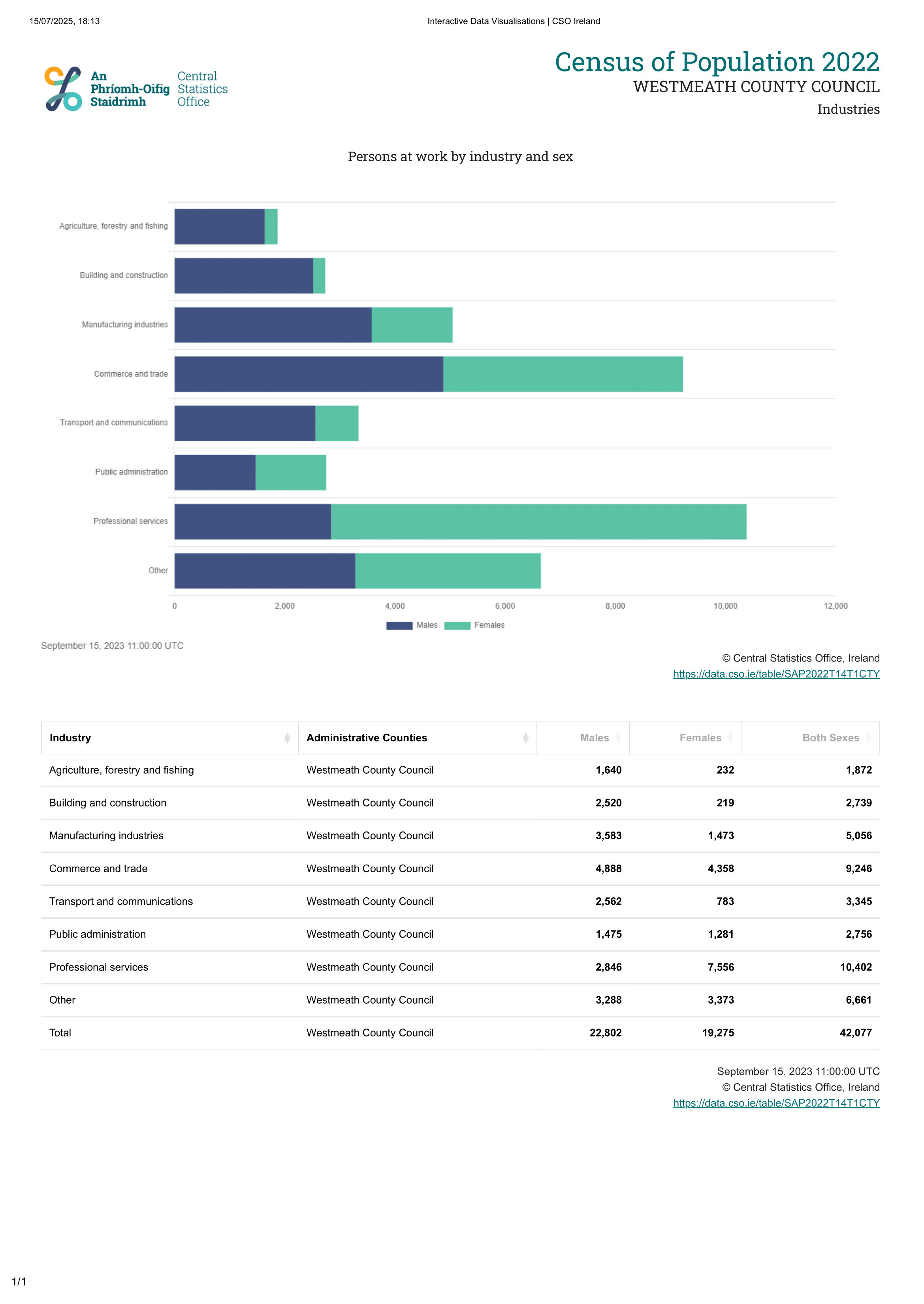About County Westmeath
Info from Draft Westmeath County Development Plan 2021-2027 - download a full copy of the draft plan HERE
Located in the heart of Ireland, County Westmeath covers an area of 1,756 square kilometres and is historically known as the ‘Lake County’, rich in arts, culture, heritage and natural amenities. These many natural amenities include the Hill of Uisneach, the mythological and sacred centre of Ireland, the River Shannon and Lough Ree, adjacent to Athlone, the River Brosna, Lough Owel and Lough Ennell, adjacent to Mullingar, with Lough Derravaragh, Lough Lene and Lough Sheelin in the north of the County. In terms of national and international tourism promotion, Westmeath’s appeal is recognised and benefits from the dual promotion of Fáilte Ireland’s ‘Ancient East’ brand proposition to the east of the County and ‘Ireland’s Hidden Heartlands’ to the west.
Westmeath has an array of attractive towns and villages ranging from the thriving Regional Centre of Athlone, the County town of Mullingar, to the strong market towns of Moate and Kinnegad and the quaint and historical villages such as Multyfarnham, Glasson and Tyrrellspass.
The M4/N4 which traverses the County in a north-westerly direction offers the County ease of access to the greater Dublin area, with Dublin Airport and Dublin Port just one hour’s drive from Mullingar. The M6 from Kinnegad, through Athlone provides further connection to Galway and the West. The N52, an important national secondary route traversing the County, further connects the north east with the Munster region. Significant rail infrastructure enhances this connectivity, with the Dublin-Sligo railway line serving Mullingar and the Dublin-Westport/Dublin-Galway line serving Athlone. Westmeath is also home to a strategic section of the Galway to Dublin National Cycle Network (NCN.) Extending across the County from the Meath County Boundary along the existing Royal Canal Greenway to Mullingar before connecting to ‘The Old Rail Trail’ for 42km to the town of Athlone.
There are four electoral areas in the County, Mullingar, Kinnegad, Moate and Athlone which in turn form the Mullingar-Kinnegad and Athlone-Moate Municipal Districts through which many of the local services are delivered by the Council.

Business in Westmeath - Census 2022
Some highlights for Westmeath
People at Work/Unemployed
More than 76,400 people living in the county in April 2022 were aged 15 and over and of these almost 42,100 people were at work. This was an increase of 19% (from the almost 35,300 people recorded as working in Census 2016). Nationally there were 2.3 million people at work in April 2022, which was up by 16%.
More than 4,400 people were unemployed in the county in April 2022. This was considerably lower than the 2016 figure of almost 6,700 people (a decrease of 34%). The unemployment rate was 9% compared with 16% in 2016. Nationally there were almost 211,000 people unemployed compared with over 297,000 in Census 2016. The unemployment rate was 8% in 2022 compared with 13% in 2016.
There were almost 12,100 retired people in Westmeath, up 30% since Census 2016. There was a 24% increase in the number of people who were unable to work due to permanent sickness or disability to 3,825 people. The number of people looking after their home/family fell by 11% to just over 5,400.
The labour force participation rate was 61% in Westmeath, the same as the national figure. Among females the rate was 55% while for males it was 67%. Nationally the trend was similar at 56% for female labour force participation and 67% for males.
Most people in work in Westmeath were in full-time employment, with nearly 31,200 people in this category, compared with over 5,900 who were working part-time.
Where people worked
The Wholesale and Retail Trade sector accounted for the largest number of workers in the county at almost 5,400. Human Health and Social Work Activities was the next largest, with just over 5,100 workers followed by Manufacturing with more than 4,500 workers.
Working From Home
A new question was included in Census 2022 asking people whether they ever worked from home and if so, for how many days per week. There were more than 42,100 people at work in Westmeath in April 2022. Of these, over 25,800 never worked from home, while more than 5,100 people worked from home at least some of the time. Of those working from home, more than 2,800 people did so for five days per week, with 1,862 doing so for one day and 1,759 for two days each week.
Travelling to Work
There were 37,866 people travelling to work in the county in April 2022. The majority of these drove to work, with 24,378 people driving to work by car in 2022. There were 893 people travelling by bus and 339 by train. Looking at active travel, 2,897 people walked to work, up from 2,788 in 2016, while 518 people cycled, an increase of 47 people since 2016.
Commuters in the county were travelling for longer in April 2022, with an average journey time of 30.4 minutes compared with 28.8 minutes in 2016. Nationally, the average journey time increased from 28.2 minutes to 29.1 minutes between 2016 and 2022. There were 9,896 Westmeath commuters who had a journey time of less than 15 minutes, while 9,929 people had a journey time of 15 to 30 minutes. A further 5,962 people had a journey time of 60 minutes and over. More than a quarter of all working commuters in Kinnegad were travelling for over an hour, one of the highest rates in the country.
Travelling to School, College or Childcare
In Westmeath, nearly 3,100 children aged under 5 travelled to childcare or school. Most of these (almost 2,500) travelled by car, while 386 walked and 38 went by bus.
Most of the 11,134 primary school aged children (5 to 12 years old) travelling to school in the county in April 2022 also travelled by car, with 6,729 doing so. Walking was the second most common means of travel at 2,026 children. A further 1,027 children used a bus while 201 children cycled.
Of the 7,513 secondary students (those aged 13-18 years) travelling to school, 3,481 were driven to school in a car, while 139 drove themselves to school. There were 2,044 students using a bus, and 53 using the train. A further 1,160 students walked to school while 152 cycled.
For the 3,390 third-level students commuting, driving a car was the most popular means of travel, at 975 people. There were 735 students walked, while 532 used a bus. Another 335 students travelled by train, DART or Luas while 331 were driven in a car.

